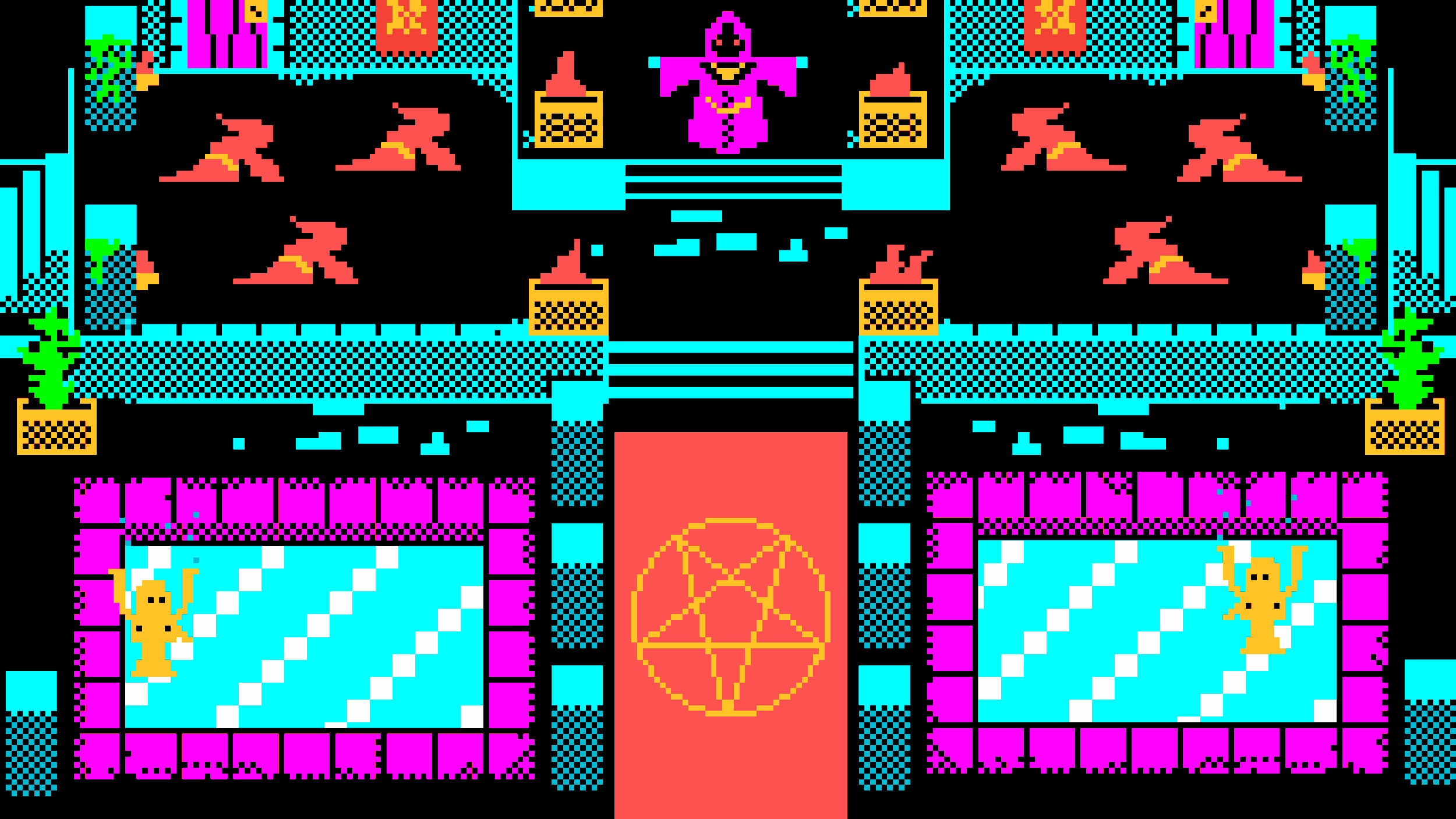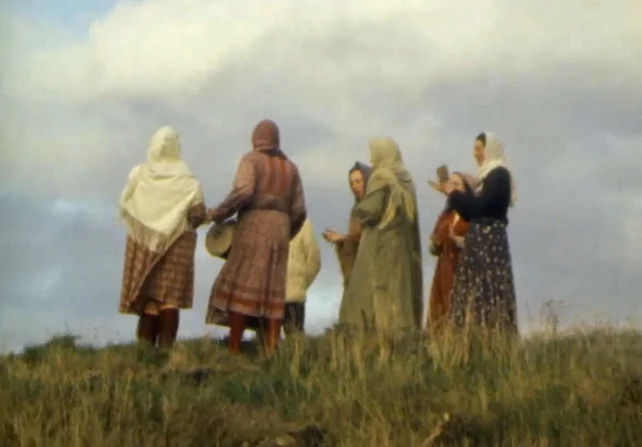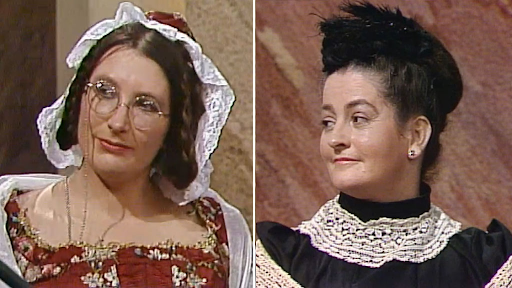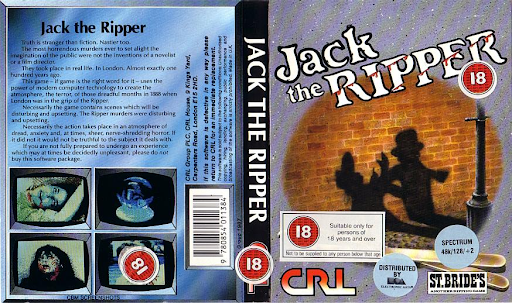How Victorian Cultists in Rural Donegal Created the World's First 18 Rated Video Game

Artwork by @spicebag.exeIn September 1982 a group called the Silver Sisterhood, also known as the Rhennes, moved to Burtonport, Donegal. Come on Eileen had just squeezed out Eye of the Tiger for the no. 1 spot in the Irish charts when the female-led community moved into the former house of the Screamers.
The sisters were part of a Rhennish faith and referred to themselves as maids rather than women (there was also one male member but he left soon after arriving in Donegal). They claimed that their group was a surviving remnant of a 5000 year old matriarchal tradition which revered God as a woman. Naturally, they believed that modern patriarchy was a new invention which would inevitably be succeeded by a matriarchal golden age for humanity. The Rhennish mystic faith came with its own language and a wealth of traditional songs and stories. Their lifestyle involved daily prayer, weekly fasting and a commitment to modesty — which would be taken to new extremes in the years to come.
In some ways their archaic religious lifestyle was more progressive than that of conservative Catholic Ireland. The maids celebrated women’s autonomy and financial independence, accepting both heterosexual and homosexual relationships within the household. An American journalist, a self-proclaimed lesbian feminist, visited the Sisterhood in 1984, and aside from being asked to switch out her trousers for a skirt and to cover her head, she was treated with nothing but kindness and respect. This was nine years before the decriminalisation of homosexuality in Ireland and only a year after Ireland’s first Pride festival, which began as a response to the homophobic murder of 30-year-old Declan Flynn. In a time when the Irish were not understanding of gay people, you could make an argument that this 5000 year old cult was ahead of their time.
Aside from the mystical pagan beliefs, the Rhennes’ lifestyle centered around music and storytelling. I am sure that on a Friday evening once all the fasting and praying was done it was as much, if not more craic than most Irish households in the early 80s. With all handmade instruments and communal songs you could see some appeal in it, though likely the same has been said for many famous cults throughout the years. That's not to equate the Rhennes to the Manson Family. All signs point to this original group being a relatively harmless nouveau-pagan commune that just wanted to escape modern life. It wasn’t until they started dressing as Victorian Romantics that things started to get really strange.

In 1984 the maids renamed their group to St. Brides and seemingly shed much of their past identity. Though sharing some of the same members and remaining in their house, An Droichead Beo, this evolution of the sisterhood looked nothing like the Rhennish community that came before it. The name change signaled a switch over from a pagan hippie commune to a pseudo-Christian Victorian boarding school, and while they still believed in a matriarchal society with God as a woman, their vocabulary and customs became definitively more Christian.

Miss Tyrrell & Miss Reiner of St Bride’s on The Late Late, 1988.
Abandoning their folk musical culture, the women of St. Bride’s began to lean heavily into the Victorian lifestyle. This included a strict Victorian dress code, though no individual year of Victoria’s reign (1837 - 1901) was specified. The petticoat clad ladies lived in their own isolated bubble, trapped in the past and far away from modern society, with their activities ranging from dress-making to formal education in Latin and mathematics. The house reportedly had only one plug socket which went unused for much of the group’s existence, shunning television and radio and avoiding any of the comforts of modern life where possible. Traditional values, politeness and etiquette took precedent in the Burtonport house.
Ultimately, the women of St Bride’s needed to raise money to fund this peculiar lifestyle. Their primary source of income was providing a boarding school experience to young ladies, a role-playing getaway where visitors could experience a trip to the past and a return to good old fashioned morality. As the years went by, the focus on corporal punishment — in particular the use of caning — grew to the point where the group was described as a fetish club. For the eight years of its existence, St. Bride’s toed the line between an idealistic escape from modern depravity and a house of masochistic cosplay enthusiasts. Reading the writings of Clare Tyrell, the word discipline appears to be at the forefront of her mind. Somewhere behind the lace and crinolines, the maids of St Bride’s appeared to derive a lot of pleasure from inflicting pain onto others
In addition to offering this discipline-heavy boarding school experience, the women opened up a traditional tea room in the house to raise money. As a business venture, the tea room was fairly predictable and in keeping with their nostalgic lifestyle. Their next and most famous method of fundraising, however, is much harder to explain.
St Bride’s are known in Ireland primarily as the group of eccentric Victorian women who moved into the Screamers’ house after they left for South America. Internationally however, their legacy is their eight published text adventure video games. One of the pupils, Priscilla Langridge, had brought her Commodore 64 to the house when first visiting. Headmistress Tyrell was initially skeptical of the computer but according to Langridge “she realised that unlike television, which she thinks is passive and mind-rotting, computer games call for concentration and commitment”. Tyrell went on to say “My experience was in thinking backwards. But I found they were wonderful, they were magical. I’m a great fan of racing car games.”
Building upon their successful first game The Mystery of St Bride’s (1984), the Sisters went on to create the world’s first 18 rated video game, Jack the Ripper (1987). You might categorize this game as a quasi-occult Victorian horror. A unique gory expansion on Ireland’s celebrated literary tradition and, to be honest, not a half bad story. The game is reminiscent of Dorian Grey but also uniquely identifiable as the output of religious nutters. You are placed in Victorian England and are falsely accused of being London’s most notorious killer, and the only way to prove your innocence is to find the real Ripper and clear your name. What begins in acts One and Two as a historic detective fantasy ends as a righteous crusade against the forces of evil.

The story culminates in a baffling blend of mysticism and Christian imagery with golden idols, blinding lights and an honest to Jesus crucifixion. This true crime video game shifts tone midway through into fan-fiction of a post-rapture battle for the goodness of man. Your hero embodies the messianic ideal, growing old through this dive into the occult world, sacrificing youth and body to give hope to humanity. Ultimately the final screen reveals this to be a Sisyphean crusade that is doomed to be repeated for the remainder of human existence.
With the dark serial killer subject matter and the controversial 18 age rating, you’d not be blamed for getting hyped for this back in 1987. The first half is about what you’d expect and expanded the realms of what you thought possible on a Commodore 64, but after watching a full play-through of this weird text adventure you feel like you’ve been hoodwinked into going to mass. The whole thing pangs of Christian rock or Gaeltacht Avicii covers, trying to appeal to new young audiences and impose a way of life on unsuspecting people using trendy methods.
You wouldn’t think that a group of religious matriarchs clad in Victorian cosplay could produce a decent horror video game but here we are. The game lands somewhere in between Sherlock Holmes and the Book of Revelations but despite this fact the reviews were glowing. It might have helped that upon original release the game was impossible to finish and crashed in act 3 before the Christian martyr ending.
The reputation of this group in Ireland deteriorated over the years and in 1992 they left their home on the Atlantic coast and moved to Oxford. The commune presented itself to the world as a pious group of women rejecting the immoral modern world and instead choosing to return to a more civilised time. The ladies of St.Bride’s talked of depravity and tawdriness of the modern world and exhibited themselves as pillars of morality. However, when the ladies left their Donegal abode, this lovely facade came crashing down. When Anne Barr and Mary Kelly of the Screamers returned to check on the vacated house they discovered “Neo-Nazi writings, antisemitic leaflets, fetish material, two year long correspondence with BNP member and letters from Irish farmers inquiring about BDSM”
Right wing periodicals, fetish magazines featuring “women in gas masks and suspenders” and pricing lists for fetish equipment like “handcuffs and leg-irons” lay strewn across the floors when Barr and Kelly visited the property. Additionally, there was evidence of a two year correspondence between the maids of St Bride’s and British National Party chairman John Tyndall, who seemingly shared some values with the Victorian organisation.
Headmistress Clare Tyrell did not abandon her ideology when the group exiled themselves to England. Once moving to Oxford she restyled herself as Miss Martindale and released a number of books including The Female Disciplinary Manual, which its publisher described as “a complete guide to the correction and chastisement of young ladies.” They sell the book with an extraordinarily unsettling description:
“The art of spanking is taught in loving detail; the use of the cane expounded to a depth never before attempted in print. The intricacies of the strap are laid before the reader in all their charm and severity.”
Martindale made a name for herself as an author and columnist representing the Aristasians, a subculture of women sharing the ideology of St Bride’s. Her group also famously ran the Anti-Metric Society in the UK. Though she had abandoned her house and community in Donegal, the video game legacy of St. Bride’s stayed with her. As the Aristasians declined in popularity they moved online, specifically seeking to create a new virtual home for themselves in the video game Second Life. The Aristasian embassy promised “groups of girls to be found chatting at all hours of night and day”.

The Aristasian embassy in video game Second Life
What began as a relatively harmless hippie commune on the Atlantic coast in 1982 turned into something infinitely more confusing and bizarre by the time of their exodus a decade later. The re-brand in 1984 to St.Bride’s signaled a complete change in the direction and ideology of the Silver Sisterhood. They will ultimately be remembered as a quirky video game company by retro game enthusiasts and as a group of Victorian role-players by those who remember the Screamers. The truth is something more nuanced, more unsettling and much more discipline focused.
Browser based versions of the game can be found online as well as hours of play-though footage on YouTube for those interested in experiencing the game firsthand.